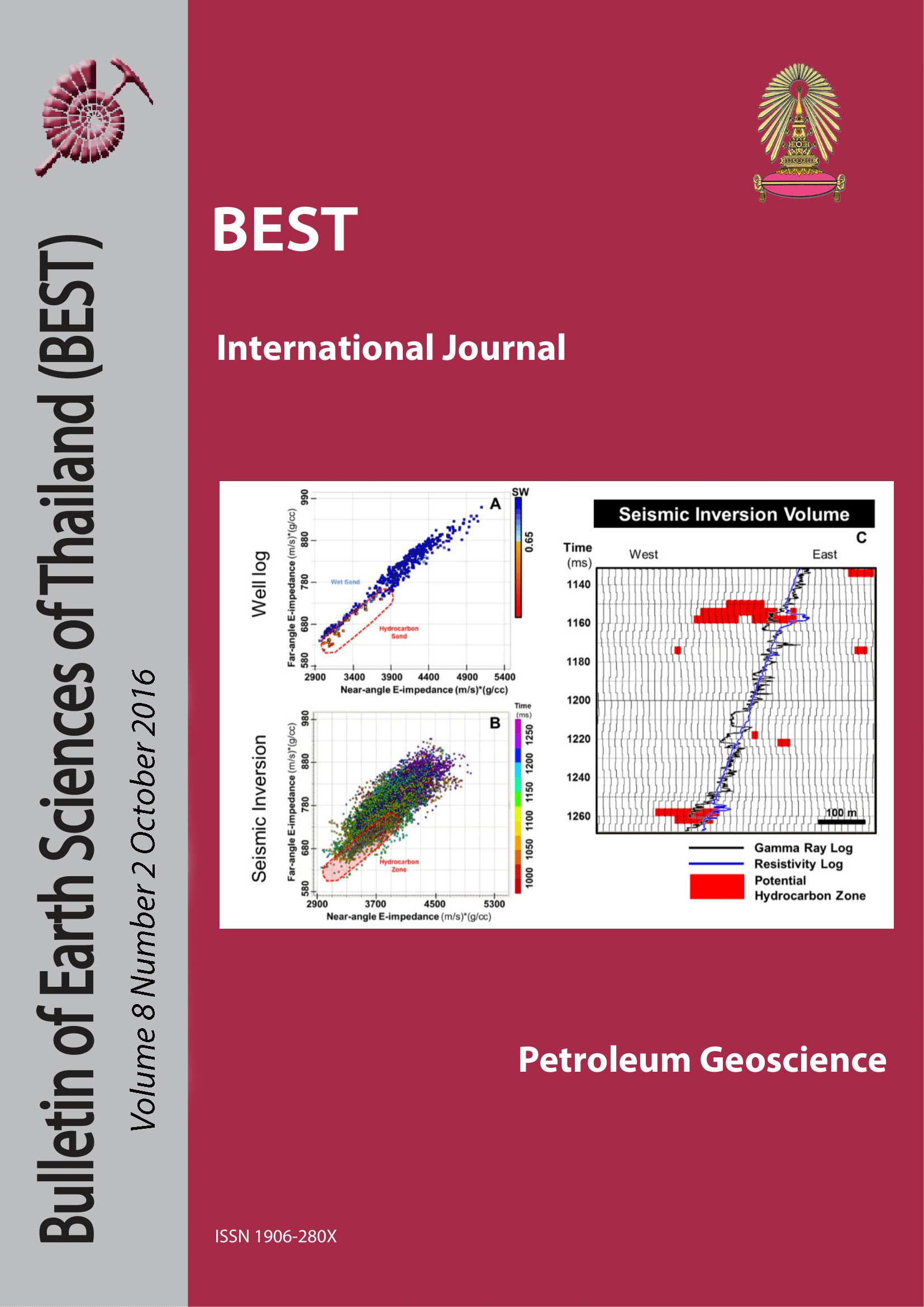POROPERM CONTROLS IN THE CARBONATE RESERVOIR IN SIN PHU HORM FIELD, NE THAILAND: USING A COMBINATION OF CUTTINGS, ISOTOPES AND FMI
Main Article Content
Abstract
Dolomites and silicified fractured and brecciated carbonates of the Pha Nok Khao Formation constitute the main petroleum reservoir in Sin Phu Horm Field. Rapid lateral changes in reservoir quality between nearby wells (less than a km apart) suggest that not only stratabound diagenesis, but also structure associated diagenesis, likely control reservoir properties across the field. Better understanding of the relationships and timings of fracturing and diagenetic evolution, via detailed quantification of many factors that can inhibit porosity loss or enhance porosity is needed to predict reservoir quality in such a complex setting. Even more useful is an ability to relate the various stages of porosity evolution with respect to timing of hydrocarbon migration. hese goals are achieved in this study via the integration of: 1) FMI interpretation (including orientations of open versus closed fractures), 2) petrography and 3) texture-aware isotope determinations. he stable isotope cross plot (carbon – oxygen), define two distinct trends of the diagenesis in the field, which tie to passive margin burial, later followed by uplift driven by Himalayan inversion. Ongoing post-deposition, compaction and pressure dissolution result the calcite cement precipitation and the overall loss of matrix porosity in the mesogenetic realm. he thrusting during Indosinian orogeny likely created an initial fracture porosity in the buried Permian carbonate. From FMI interpretation and petrography, most of the early fractures were filled by calcite cement so the preservation potential of fracture porosity related to burial and the Indosinian orogeny is low. Effective porosity in the Sin Phu Horm reservoir believe to be associated with cooling, fracturing and entry of fluids with isotope signatures interpreted as belonging to the catagenic plot field. his event can be tied to the early telogenetic as deeply circulating meteoric-influenced waters, perhaps mixed with remnant catagenic fluids, entered along fractures with orientations that indicate reactivation of earlier Indosinian features and newly formed fractures with orientations controlled by Cenozoic transtensional stresses. hus catagenic fluid entry occurred sometime during or immediately after the onset of the Himalaya (Paleogene) event. From FMI interpretation, the Cenozoic fracture set shows as open fractures, which increased the effective porosity and permeability in the Pha Nok Khao carbonates to levels where the formerly tight limestone host became a viable (if patchy) reservoir. Poroperm enhancement was especially so in intervals of more brittle response typically associated with zones of more abundant dolomite or silicification. Lastly, based on the successful integration of isotope timing from cuttings and fracture-orientation from FMI, it is highly recommended that future wells in the region are directional and that well directions should be planned to be orthogonal to the main set of Paleogene event-induced fractures.
Article Details

This work is licensed under a Creative Commons Attribution-NonCommercial-NoDerivatives 4.0 International License.
Copyright © 2008 Department of Geology, Faculty of Science, Chulalongkorn University. Parts of an article can be photocopied or reproduced without prior written permission from the author(s), but due acknowledgments should be stated or cited accordingly.
References
Booth, J., and N. Sattayarak, 2011, Carboniferous-Cretaceous Geology of NE Thailand, in M. F. Ridd, A. J. Barber, and M. J. Crow, eds., The Geology of Thailand, The Geological Society, London, p. 185-222.
Moore, C. H., 2001, Carbonate Reservoirs - Porosity Evolution and Diagenesis in a Sequence Stratigraphic Framework, v. 55, Elsevier, 444 p.
Morley, C. K., P. Ampaiwan, S. Thanudamrong, N. Kuenphan, and J. Warren, 2013, Development of the Khao Khwang Fold and Thrust Belt: Implications for the geodynamic setting of Thailand and Cambodia during the Indosinian Orogeny: Journal of Asian Earth Sciences, v. 62, p. 705-719.
Pantong, A., 2015, Facies Distribution and Diagenetic Evolution of a Carbonated Reservoir in Pha Nok Khao Formation, Sin Phu Horm Thailand, M.Sc. research report, Chulalongkorn University, Bangkok.
Racey, A., 2011, Petroleum Geology, in M. F. Ridd, A. J. Barber, and M. J. Crow, eds., The Geology of Thailand, The Geological Society, London, p. 351-392.
Scholle, P. A., and D. S. Ulmer-Scholle, 2003, A Color Guide to the Petrography of Carbonate Rocks: Grains, textures, porosity, diagenesis, v. 77: Tulsa, Okla, American Association of Petroleum Geologists Memoir, 459 p.
Warren, J., C. Morley, T. Charoentitirat, I. Cartwright, P. Ampaiwan, P. Khositchaisri, M. Mirzaloo, and J. Yingyuen, 2014, Structural and fluid evolution of Saraburi Group sedimentary carbonates, central Thailand: A tectonically driven fluid system: Marine and Petroleum Geology, v. 55, p. 100-121.


